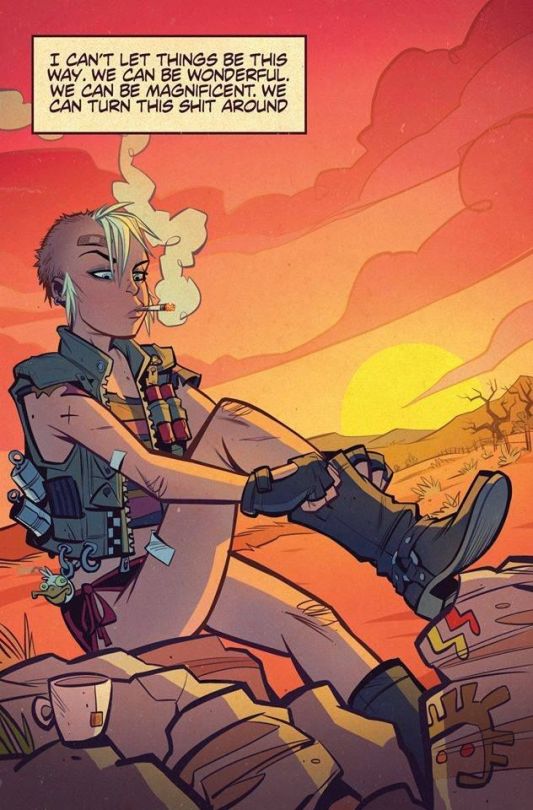#climate hope
Text
Since the 1960s, the world has seen a spike in the number of natural disasters, largely due to rising sea levels and an ever gradually increasing global surface temperature.
The good news? We’re getting better at helping each other when disasters strike.
According to a recent study from Our World In Data, the global toll from natural disasters has dramatically dropped in the last century.
“Low-frequency, high-impact events such as earthquakes and tsunamis are not preventable, but such high losses of human life are,” wrote lead authors Hannah Ritchie and Pablo Rosado.
To conduct their research, Ritchie and Rosado gathered data from all geophysical, meteorological, and climate-related disasters since 1900. That includes earthquakes, volcanic activity, landslides, drought, wildfires, severe storms, and mass floods.
In the early-to-mid 20th century, the average annual death toll from disasters was very high, often climbing to over a million.
For example, the study cites that in 1931, 2.7 million people died from the Yangtze–Huai River floods. In 1943, 1.9 million died from the Bangladeshi famine of 1943. Even low-frequency events had extreme death tolls.
“In recent decades we have seen a substantial decline in deaths,” Ritchie and Rosado observed. “Even in peak years with high-impact events, the death toll has not exceeded 500,000 since the mid-1960s.”
Why has the global death toll from disasters dropped?
There are a number of factors at play in the improvement of disaster aid, but the leading component is that human beings are getting better at predicting and preparing for natural disasters.
“We know from historical data that the world has seen a significant reduction in disaster deaths through earlier prediction, more resilient infrastructure, emergency preparedness, and response systems,” Ritchie and Rosado explained in their study.
On April 6, [2024],a 7.2 magnitude earthquake rocked the city of Hualien in Taiwan. Days later, as search and rescue continues, the death toll currently rests at 16.
Experts have praised Taiwan for their speedy response and recovery, and attributed the low death toll to the measures that Taiwan implemented after an earthquake of similar strength hit the city 25 years earlier. Sadly, on that day in 1999, 2,400 people died and 11,000 were injured.
In an interview with Al Jazeera, Wang Yu — assistant professor at National Taiwan University — said that event, known as the Chi-Chi earthquake, revolutionized the way Taiwan approached natural disasters.
“There were lots of lessons we learned, including the improvement of building codes, understanding earthquake warning signs, the development and implementation of earthquake early warning (EEW) systems and earthquake education,” said Wang.
Those same sensors and monitoring systems allowed authorities to create “shakemaps” during Hualien’s latest earthquake, which helped them direct rescue teams to the regions that were hit the hardest.
This, in conjunction with stronger building codes, regular earthquake drills, and public education campaigns, played a huge role in reducing the number of deaths from the event.
And Taiwan’s safeguards on April 6 are just one example of recent measures against disasters. Similar models in strengthening prediction, preparedness, and recovery time have been employed around the world when it comes to rescuing victims of floods, wildfires, tornados, and so on.
What else can we learn from this study?
When concluding the findings from their study, Ritchie and Rosado emphasized the importance of increasing safety measures for everyone.
Currently, there is still a divide between populations with high gross national income and populations living in extreme poverty.
Even low-income countries that infrequently have natural disasters have a much higher death rate because they are vulnerable to collapse, displacement, and disrepair.
“Those at low incomes are often the most vulnerable to disaster events; improving living standards, infrastructure, and response systems in these regions will be key to preventing deaths from natural disasters in the coming decades,” surmised Ritchie and Rosado.
“Overall development, poverty alleviation, and knowledge-sharing of how to increase resilience to natural disasters will therefore be key to reducing the toll of disasters in the decades to come."
-via GoodGoodGood, April 11, 2024
#good news#hope#climate change#hope posting#climate news#climate crisis#climate anxiety#climate emergency#natural disasters#disasters#earthquake#wildfire#hurricane#cw death#taiwan#tsunamis#building construction#climate action#climate hope
275 notes
·
View notes
Text
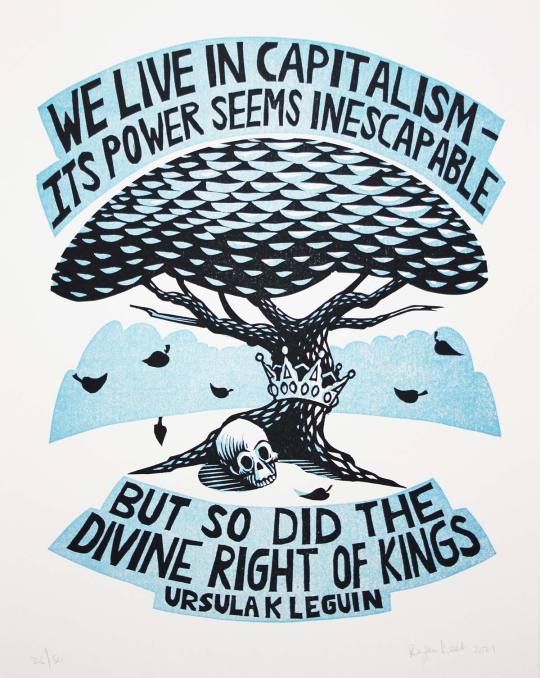
Artist credit:
#ursula k. le guin#hopepunk#hope punk#solar punk#solarpunk#futurism#climate and environment#climate action#climate hope#climate chaos#clean energy#capitalist society#capitalism#capitalist dystopia#resistance#faith in the future#economic justice#workers rights#imagine better
2K notes
·
View notes
Link
“It all starts with the transition to clean energy, now approaching full speed with 87 countries drawing at least 5% of their electricity from wind and solar. The US hit 5% in 2011 and surged past 20% renewable electricity last year. If the country follows the trend set by others at the leading edge, wind and solar will account for half of US power-generating capacity just 10 years from now. That would be years—or even decades—earlier than major forecasts.
[...] Successful technologies follow an S-shaped adoption curve. Sales move at a crawl in the early-adopter phase, then surprisingly quickly once things go mainstream. The top of the curve represents the last people to make the transition. Even in 2022, a tenth of humanity still doesn't have electricity.
Five percent isn't a universal tipping point. Some technologies flip sooner, others later, but the basic idea is the same: Once the tough investments in manufacturing have been made and consumer preferences start to shift, the first wave of adoption sets the conditions to go much bigger."
#green energy#clean energy#renewable energy#climate change#global warming#environment#ecology#climate hope#climate anxiety#environmental grief#good news#hope#slow horses#electrify#electrify everything#hopepunk
972 notes
·
View notes
Text



Eurasian griffon vultures (Gyps fulvus) in the Mariola mountains of Alcoi, Central Valencian Country.
This bird species had gone extinct in the area, but since the year 2000 the FAPAS Foundation has been working on a project to reintroduce them in the Canyet de les Pedreres fauna reserve area. The project has been successful and is now a referent when it comes to vulture populations in all the Iberian peninsula (which is saying a lot, considering that 90% of Europe's vultures live in the Iberian peninsula!), with about 80 wild vultures living there nowadays.
Once a week, the city council compiles the unwanted remains from local butchers' and brings them to the mountain for the vultures to eat. In that spot, there is a "hide" (a wooden cabin for birdwatching) where people can go to watch the vultures eating, as long as they stay silent to avoid disturbing the birds, though the vultures might take hours to come, since they're wild animals.
The local butchers, farmers, and hunters contribute to the project donating their unwanted meat, because the reintroduction of this species is mutually beneficial for the environment and for economical reasons. On the one hand, vultures exclusively eat dead animals and sometimes ill animals, which means that they help stop the spread of pathogens among animals, which also results in less illnesses in farm animals. On the other hand, by using vultures instead of industrial plants to treat and dispose of meat products, we can avoid economical expense and reduce the amount of greenhouse gases that would be emitted during the industrial treatment.
Photos by Eva Máñez, text translated and adapted from Raúl Abeledo Sanchis, both published in Guía Repsol.
#natura#alcoi#país valencià#fauna#sustainability#environment#wildlife#vulture#gyps fulvus#nature#birds#birdwatching#wildlife photography#ecology#environmentalism#solarpunk#climate hope#climate#ecofriendly#wild animals
75 notes
·
View notes
Text
#good news#nature#science#environmentalism#environment#climate change#climate change mitigation#climate crisis#climate hope#energy#renewable power
112 notes
·
View notes
Text
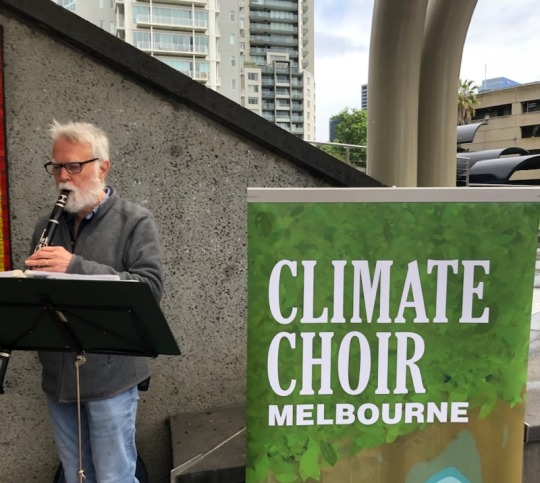
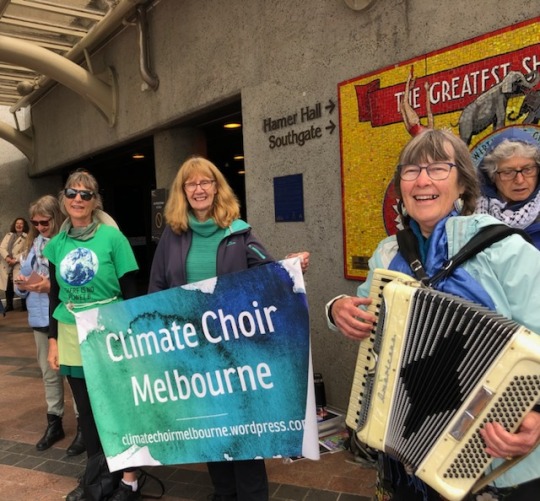
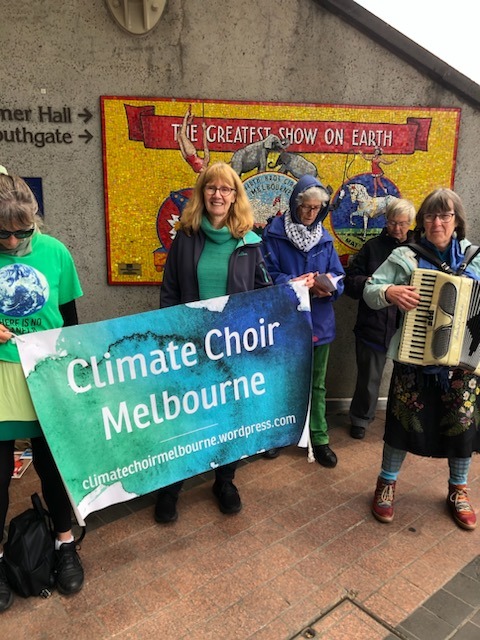
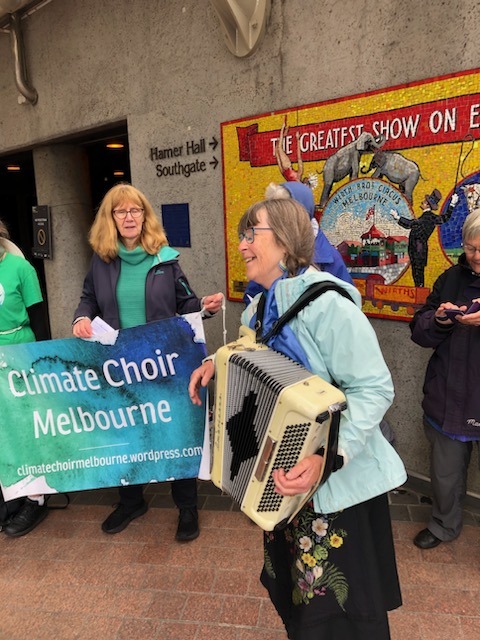
A joyful and effective means of spreading your urgent message. Start up a Climate Choir in your community.
#climate choirs#jail climate criminals#we want climate action now#climate change#cambio climático#climate crisis#prepare for climate change#greenwashing#big oil#fossil fuel industry#plastic#climate washing#floods#climate activism#calentamiento globa#medio ambiente#IPPC#climate hope#sea level rise#late stage capitalism#victims of capitalism#klimakatastrophe#klimawandel#changement climatique#qihou bianhua#izmeneniye klimata#cambiamento climatico#気候変動#जलवायु परिवर्तन#jalavaayu parivartan
24 notes
·
View notes
Text
Sorry for the repeated enviromental posting over the past few days its the only way i'm able to climb my way out of complete climate doomspiralling and sobbing to myself about unrealistic worst case scenarios. Back to the fandom blogging for a bit I can't afford another breakdown and spiral. I literally can't. I need hope at least just for tomorrow.
#the existensial dread will still be around for quite a while#but i blocked several doomerist yt channels and r/collaspe and i feel better after doing actual research#tw climate change#tw climate doomerism#tw doomscrolling#catastrophism#climate change#climate justice#ecology#biodiversity#humanity#climate hope
71 notes
·
View notes
Text
Reminder that we need to keep hope about the world. If we lose hope, then we'll be dooming ourselves to face the fate we all fear. Apathy does nothing but seals our fates. It sucks, its hard, but for the love of god, keep hope, keep fighting for change, and keep working towards a brighter future.
#there is still hope#there fucking is#its grim#its serious#but there is fucking hope#and constantly focusing on the bad and freaking yourself and others out to the point of hopelessness is not productive#all it does is play into the wishes of the people making the world this shitty#climate change#climate crisis#climate hope#anti capitalist#anti genocide#hope
9 notes
·
View notes
Text
Dear world. Dear those who have the power to stop this. Dear people who could make a change but won’t
By the time you get this it will be too late
For days upon end this month fires have raged and burned, yet you say ‘it’s not that bad! The smoke is fine to breathe’, and you continue to heal the promises you made as you dig another oil line.
This week has started for me with a heat wave, sweat dribbling down my legs, and an itchy nose from all the polen. Storms have been raging on the evenings, and as much as I like storms -for they are very calming- I can’t help but think that the storm’s usually come after the summer, not right at the beginning. Or just before, even, in spring. But no, here are the storms and the heat waves in June.
It wasn’t this warm this time last year, or the year before, or the year before that. Or any year I can remember in fact. We had to switch out our winter duvets for the summer ones much sooner this year, and already I don’t want to have a blanket on my bed at all. I hate the sounds of the plug in fans whirring through the night; this country doesn’t come with air-con in the houses, just some fancy schools and offices for rich workers ran by richer people. I bet they have air-con in parliament, where they sit and discuss the rising temperatures, melting ice caps, and never seem to really do anything about it.
Did you know that just stop oil disrupted a flower festival last week? I wouldn’t choose that particular place myself, but it’s admirable work when the government won’t listen any other way, and the news will not report the legal non-disruptive work. And yet my friend, who was writing a book about climate change when we were eleven, still called them the morons. Funny that.
I feel guilty, every time I have a tuna sandwich or get driven down into town when I could have walked. I really shouldn’t. And yet rich people who could speak out and make a difference take half an hour trips on private jets and feel no remorse. It saves them time and convenience. And they eat rare caviar. Big oil and fossil fuel companies that destroy habitats and pump out atmosphere destroying gasses only care about the money they receive and not the impact that what they are doing has. They don’t care that a rare species of bird just went extinct. That a polar bear cub didn’t make it out of its first weeks after I near starved then drowned due to their not being enough ice or food around.
Dear people, while you sit back and watch this happen, just know that you will be dead before this get too bad, and I’ll be left to pick up your mess. I’d not want to go into politics. I want to act or dig up segments of the past and marvel over what happened. But I might just need to take a seat at that table to get things to go right.
#poem#poem of the day#poetsofinstagram#poemsbyme#poetic#poetsandwriters#poet#poetblr#poets corner#young poets#poems and poetry#poetry#environmetalists#ecofriendly#activist poetry#climate chaos#climate hope#climate action#climate change#global crisis#global warming#ice caps#fires#help us#stand up#unite#do something#today#before we all#burn alive
44 notes
·
View notes
Text
This Is The Best Book I’ve Ever Read to Empower Anyone with Real Climate Hope
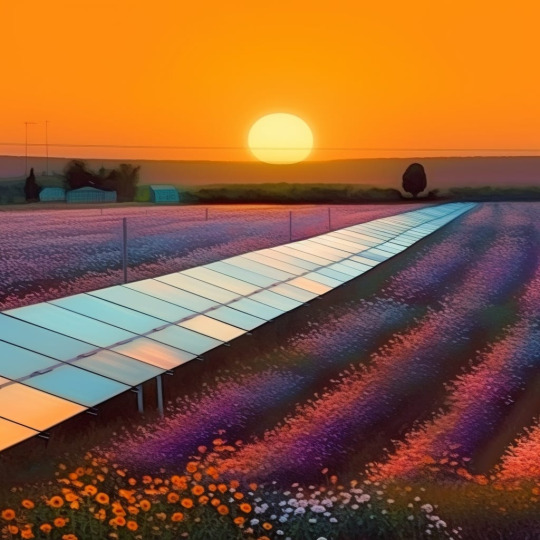
READ MY REVIEW👉 Not Too Late: Changing the Climate Story from Despair to Hope
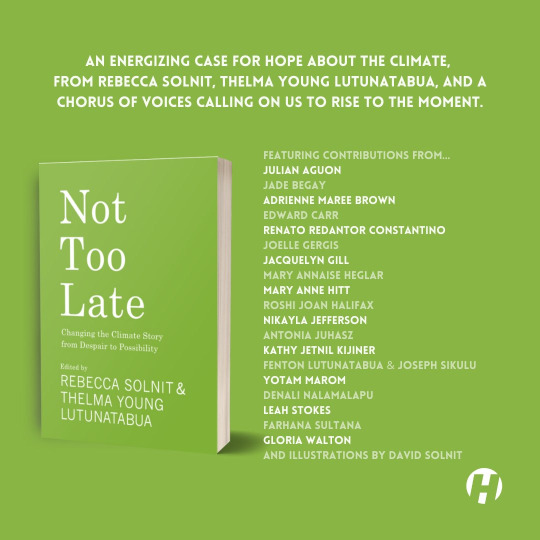
"To hope is to accept despair as an emotion but not as an analysis. To recognize that what is unlikely is possible, just as what is likely is not inevitable."
—Rebecca Solnit
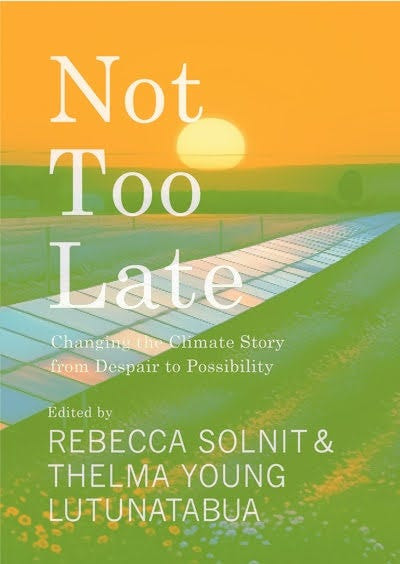
What gives me hope is that human history is full of examples of people across the ages who have risen to face the great challenges of their time and have succeeded. Victory is not the arrival in some promised land; it is the series of imperfect victories along the way that edge us closer to building the critical mass that eventually shifts the status quo.” —Rebecca Solnit
Not Too Late: Changing the Climate Story from Despair to Hope
#climate hope#climate#climate change#climate art#climate optimism#climate action#climate justice#climate book#book review#book recommendations#environment#earth month#book#books#rebecca solnit#renewable energy#renewable power#courage#climate solutions#favorite quotes#quotes#inspiration#inspiring quotes#envrionment#environmental communication#climate communication#favorite books#despair#possibility#climate story
38 notes
·
View notes
Text
No paywall version here.
"Two and a half years ago, when I was asked to help write the most authoritative report on climate change in the United States, I hesitated...
In the end, I said yes, but reluctantly. Frankly, I was sick of admonishing people about how bad things could get. Scientists have raised the alarm over and over again, and still the temperature rises. Extreme events like heat waves, floods and droughts are becoming more severe and frequent, exactly as we predicted they would. We were proved right. It didn’t seem to matter.
Our report, which was released on Tuesday, contains more dire warnings. There are plenty of new reasons for despair. Thanks to recent scientific advances, we can now link climate change to specific extreme weather disasters, and we have a better understanding of how the feedback loops in the climate system can make warming even worse. We can also now more confidently forecast catastrophic outcomes if global emissions continue on their current trajectory.
But to me, the most surprising new finding in the Fifth National Climate Assessment is this: There has been genuine progress, too.
I’m used to mind-boggling numbers, and there are many of them in this report. Human beings have put about 1.6 trillion tons of carbon in the atmosphere since the Industrial Revolution — more than the weight of every living thing on Earth combined. But as we wrote the report, I learned other, even more mind-boggling numbers. In the last decade, the cost of wind energy has declined by 70 percent and solar has declined 90 percent. Renewables now make up 80 percent of new electricity generation capacity. Our country’s greenhouse gas emissions are falling, even as our G.D.P. and population grow.
In the report, we were tasked with projecting future climate change. We showed what the United States would look like if the world warms by 2 degrees Celsius. It wasn’t a pretty picture: more heat waves, more uncomfortably hot nights, more downpours, more droughts. If greenhouse emissions continue to rise, we could reach that point in the next couple of decades. If they fall a little, maybe we can stave it off until the middle of the century. But our findings also offered a glimmer of hope: If emissions fall dramatically, as the report suggested they could, we may never reach 2 degrees Celsius at all.
For the first time in my career, I felt something strange: optimism.
And that simple realization was enough to convince me that releasing yet another climate report was worthwhile.
Something has changed in the United States, and not just the climate. State, local and tribal governments all around the country have begun to take action. Some politicians now actually campaign on climate change, instead of ignoring or lying about it. Congress passed federal climate legislation — something I’d long regarded as impossible — in 2022 as we turned in the first draft.
[Note: She's talking about the Inflation Reduction Act and the Infrastructure Act, which despite the names were the two biggest climate packages passed in US history. And their passage in mid 2022 was a big turning point: that's when, for the first time in decades, a lot of scientists started looking at the numbers - esp the ones that would come from the IRA's funding - and said "Wait, holy shit, we have an actual chance."]
And while the report stresses the urgency of limiting warming to prevent terrible risks, it has a new message, too: We can do this. We now know how to make the dramatic emissions cuts we’d need to limit warming, and it’s very possible to do this in a way that’s sustainable, healthy and fair.
The conversation has moved on, and the role of scientists has changed. We’re not just warning of danger anymore. We’re showing the way to safety.
I was wrong about those previous reports: They did matter, after all. While climate scientists were warning the world of disaster, a small army of scientists, engineers, policymakers and others were getting to work. These first responders have helped move us toward our climate goals. Our warnings did their job.
To limit global warming, we need many more people to get on board... We need to reach those who haven’t yet been moved by our warnings. I’m not talking about the fossil fuel industry here; nor do I particularly care about winning over the small but noisy group of committed climate deniers. But I believe we can reach the many people whose eyes glaze over when they hear yet another dire warning or see another report like the one we just published.
The reason is that now, we have a better story to tell. The evidence is clear: Responding to climate change will not only create a better world for our children and grandchildren, but it will also make the world better for us right now.
Eliminating the sources of greenhouse gas emissions will make our air and water cleaner, our economy stronger and our quality of life better. It could save hundreds of thousands or even millions of lives across the country through air quality benefits alone. Using land more wisely can both limit climate change and protect biodiversity. Climate change most strongly affects communities that get a raw deal in our society: people with low incomes, people of color, children and the elderly. And climate action can be an opportunity to redress legacies of racism, neglect and injustice.
I could still tell you scary stories about a future ravaged by climate change, and they’d be true, at least on the trajectory we’re currently on. But it’s also true that we have a once-in-human-history chance not only to prevent the worst effects but also to make the world better right now. It would be a shame to squander this opportunity. So I don’t just want to talk about the problems anymore. I want to talk about the solutions. Consider this your last warning from me."
-via New York Times. Opinion essay by leading climate scientist Kate Marvel. November 18, 2023.
#WE CAN DO THIS#I SO TRULY BELIEVE THAT WE CAN DO THIS#WE CAN SAVE OURSELVES AND THE WORLD ALONG WITH US#climate crisis#united states#climate change#conservation#hope posting#sustainability#climate news#climate action#climate emergency#fossil fuels#global warming#environmentalism#climate hope#solarpunk#climate optimism#climate policy#earth#science#climate science#meteorology#extreme weather#renewable energy#solar power#wind power#renewables#carbon emissions#climate justice
33K notes
·
View notes
Text
From Lexi Drumonde's video on Hopepunk.

#hopepunk#hope punk#solar punk#solarpunk#futurism#misinformation#clean energy#renewable energy#nihilsm#nihilizm#climate and environment#climate hope#climate action#climate doom#doomerism
144 notes
·
View notes
Text
It is so hard to stay optimistic about environmental concerns when so much bad news is constantly coming out. But at the end of the day, climate hope fuels positive social change better than climate doomerism, so all that I can do is let climate hope fuel my daily actions and my politics. This is hard but very important to remember
17 notes
·
View notes
Video
youtube
If you only ever watch one video about climate action, I recommend this one.
If you’ve ever thought, “I want to help stop climate change or protect the environment but I have no idea where to start or what I as a single person can actually do” then this video is for you.
TL/DR: There are actions that are impactful for anyone, like protesting, voting, etc. but the most impactful action for each individual person depends on your unique strengths and resources. Finding your “climate superpower” based on what you are already good at and passionate about can amplify your impact.
#climate action#climate change#environment#global warming#climate adaptation#hopepunk#solarpunk#what you can do#how you can help#inspiration#hope#climate hope#eco anxiety#climate activism#climate change venn diagram
665 notes
·
View notes
Text
“We need to build things that will last 50-100 years that will be resilient to these climate changes.”
"Met Éireann has also presented its latest data in relation to driving rain. Wind-driven rain against a wall may be partially absorbed or penetrate through cracks in the wall, therefore increasing the risk of damage to the building fabric. It is particularly prevalent in homes built in the west of Ireland.
“The current building standards use driving rain in their calculations of what blocks to use and in what construction methods to use in different parts of the country, but that data is 20 years old give or take,” he said."
#jail climate criminals #we want climate action now #climate change #cambio climático #climate crisis #prepare for climate change #greenwashing #big oil #fossil fuel industry #plastic #climate washing #floods #climate activism #calentamiento global #medio ambiente #IPPC #prepare for climate change #climate hope #sea level rise #late stage capitalism #victims of capitalism #klimakatastrophe #klimawandel #changement climatique #qihou bianhua #izmeneniye klimata #cambiamento climatico #気候変動 #जलवायु परिवर्तन #jalavaayu parivartan #das Alterações Climáticas
#sea rise#jail climate criminals#we want climate action now#climate change#cambio climático#climate crisis#prepare for climate change#greenwashing#big oil#fossil fuel industry#plastic#climate washing#floods#climate activism#calentamiento global#medio ambiente#IPPC#climate hope#sea level rise#late stage capitalism#victims of capitalism#klimakatastrophe#klimawandel#changement climatique#qihou bianhua#izmeneniye klimata#cambiamento climatico#気候変動#जलवायु परिवर्तन#jalavaayu parivartan
29 notes
·
View notes
